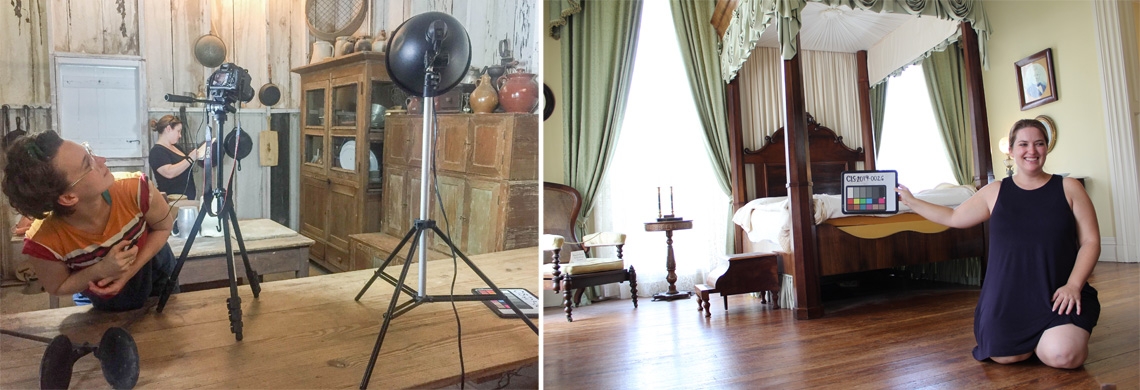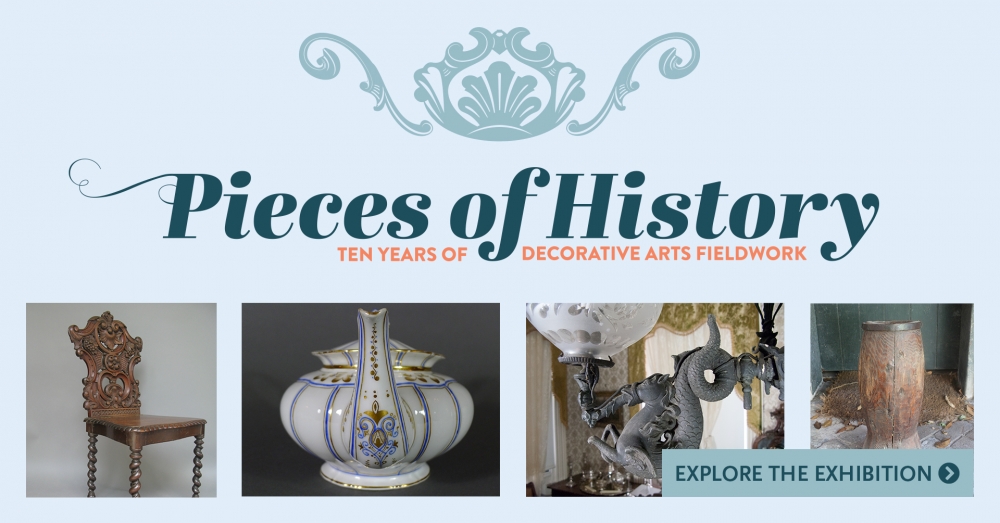Since 2011, graduate students and other emerging museum professionals have spent their summers traveling throughout Louisiana, Mississippi, and Alabama cataloging historic objects made or used in the region before 1865. Records of these objects comprise the Decorative Arts of the Gulf South (DAGS) database that offers researchers a view of material culture beyond the region's museums and public collections. The new exhibit Pieces of History: Ten Years of Decorative Arts Fieldwork celebrates the 10th anniversary of DAGS, which was previously known as the Classical Institute of the South.
 Each fieldwork experience is a classic American road trip paired with a historical scavenger hunt. No two years are just alike, but each team returns home with an abundance of adventure stories and a new appreciation for the people and places of the Gulf South. Here are some of our favorite memories from the past 10 years.
Each fieldwork experience is a classic American road trip paired with a historical scavenger hunt. No two years are just alike, but each team returns home with an abundance of adventure stories and a new appreciation for the people and places of the Gulf South. Here are some of our favorite memories from the past 10 years.
Problem Solving
Working with a mobile photography studio to capture the contents of people’s homes is always unpredictable. DAGS teams usually must rearrange furniture and adjust window coverings to get the perfect shot. Summer heat, dust, insects, and poor cell phone reception for internet research are common. Each site has its own challenges, and fellows rise to the occasion with ingenuity and good humor.
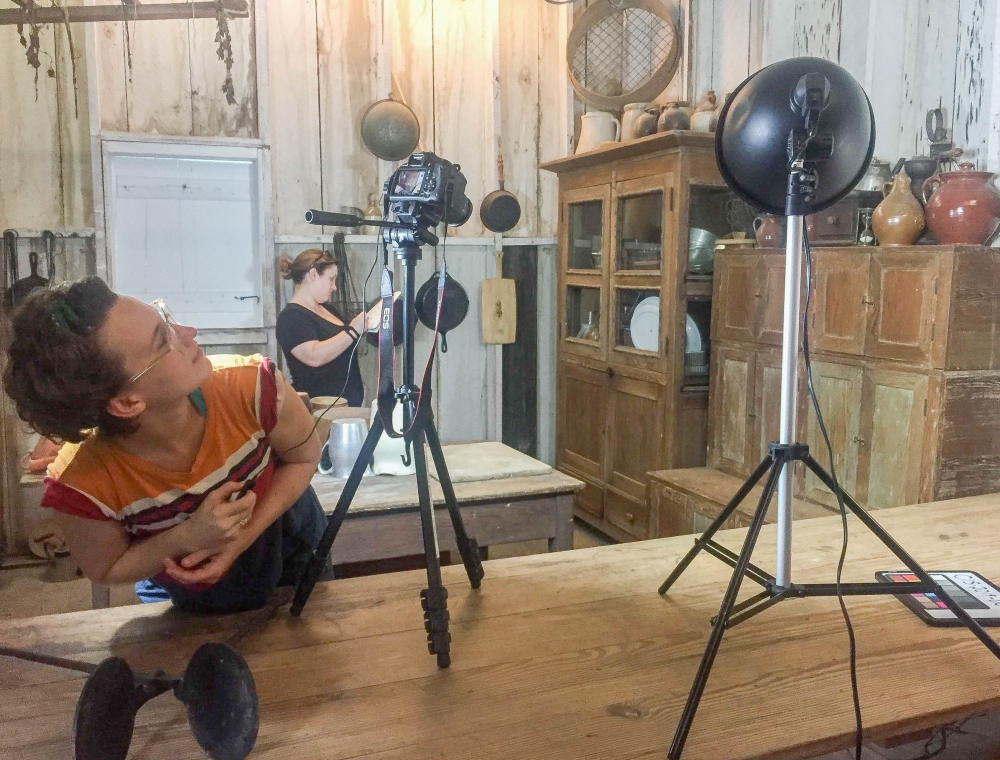
Emily Wells (foreground) and Courtney Christy, 2019 DAGS fellows, catalog in the Oakley Plantation kitchen in St. Francisville, Louisiana.
For example, the 2012 team worked entirely in historic homes with no air conditioning. They adjusted their working hours to start early in the morning to finish before the afternoon heat. Lea Lane, a 2015 fellow, fondly remembers the day her team settled on pink camouflage duct tape to reattach a broken side mirror to their Chevy Tahoe. Every DAGS team gets a reputation for being “those people who climb under furniture” as they study every aspect of an object.
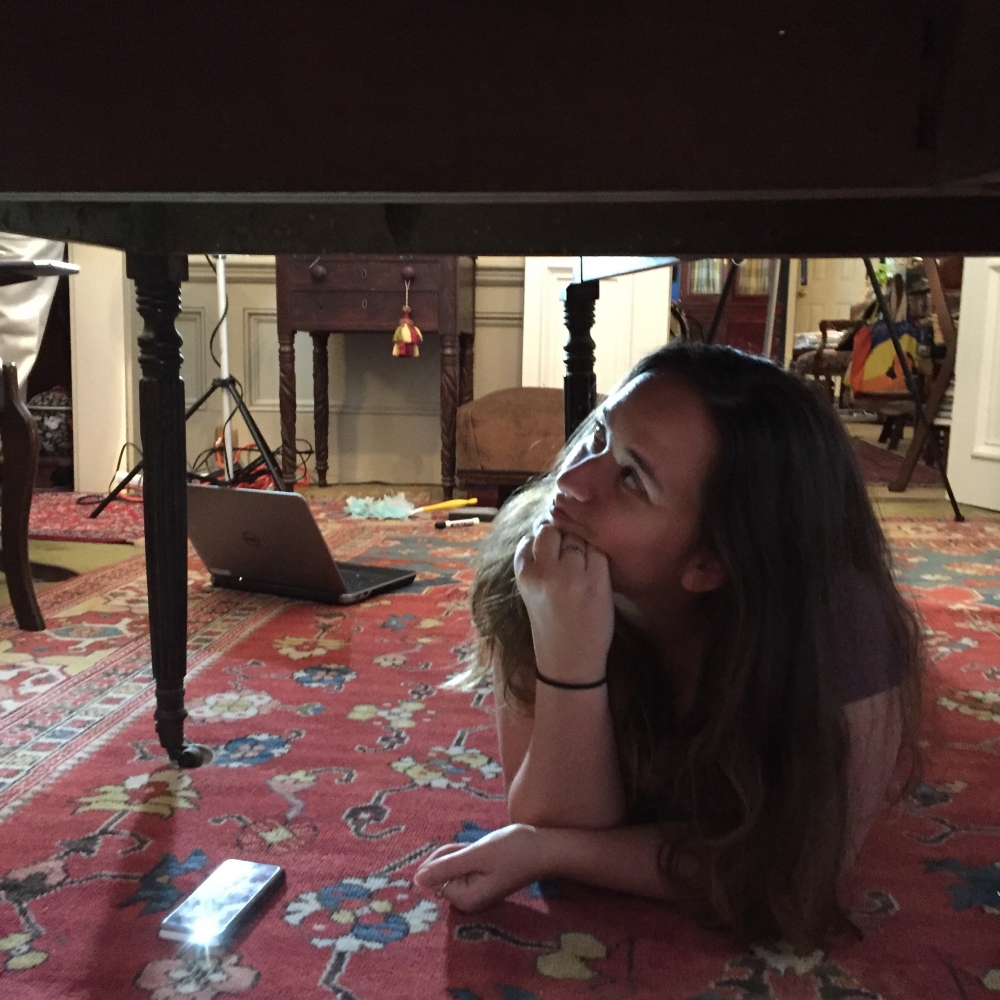 2016 fellow Michelle Fitzgerald examines the underside of a table in Woodville, Mississippi.
2016 fellow Michelle Fitzgerald examines the underside of a table in Woodville, Mississippi.
Perhaps the most challenging summer was in 2019, when THNOC Decorative Arts Curator Lydia Blackmore and I were both “gestating while curating” before the birth of our sons. Since I had a higher-risk twin pregnancy, my doctor forbade me to travel beyond Baton Rouge. Lydia accompanied the fellows to Natchez, where she only briefly got stuck examining the underside of a tester bed. The team made it back to New Orleans just before Hurricane Barry hit Louisiana!
Hunting for maker’s mark under this Natchez tester bed got Lydia Blackmore and her pregnant belly into a tight spot in 2019.
Once the rains stopped, I took the fellows to St. Francisville, Louisiana. The park rangers at Oakley Plantation in the Audubon State Historic Site were very accommodating of my enormous state and drove me around the wooded paths in a John Deere Gator ATV. The fellows gladly handled all the furniture moving and equipment hauling. Fortunately, my baby boys stayed put until the Monday after our return. I will always fondly remember our last adventure together before their public debut.
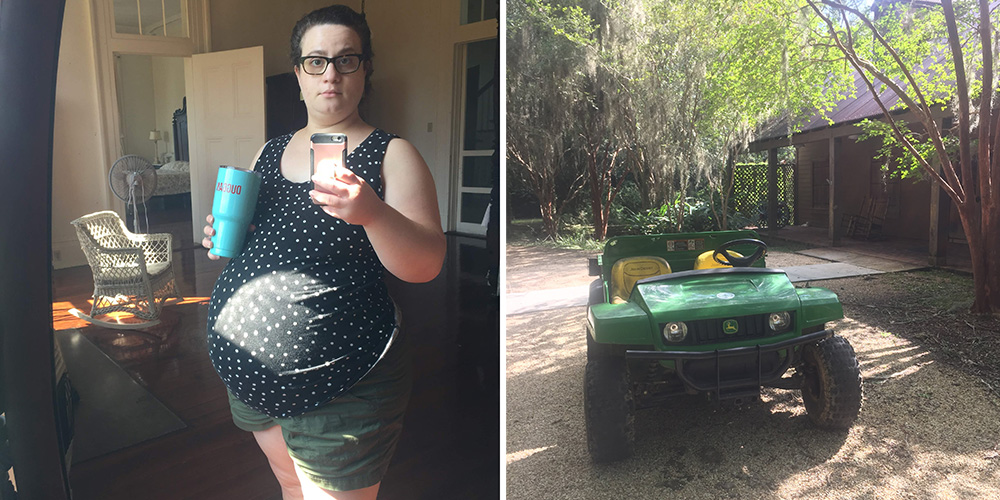
Left: Me, very pregnant and doing my best to stay hydrated while cataloging outside Baton Rouge. Right: My trusty Gator chariot awaits at Oakley Plantation.
Modern Surprises
When examining antique furniture that is still in daily use, we expect the unexpected. Rolls of Christmas wrapping paper might tumble out of an armoire, or a piano might be covered in family photos and knick-knacks we must remove for photos and replace just as they were. In one house museum, we discovered a long-forgotten sack lunch and pair of sweatpants a docent had stashed in a cabinet!
I’ll never forget how startled I was to open a bedroom drawer at the Demopolis, Alabama, house museum Gaineswood and find these spare mannequin hands!
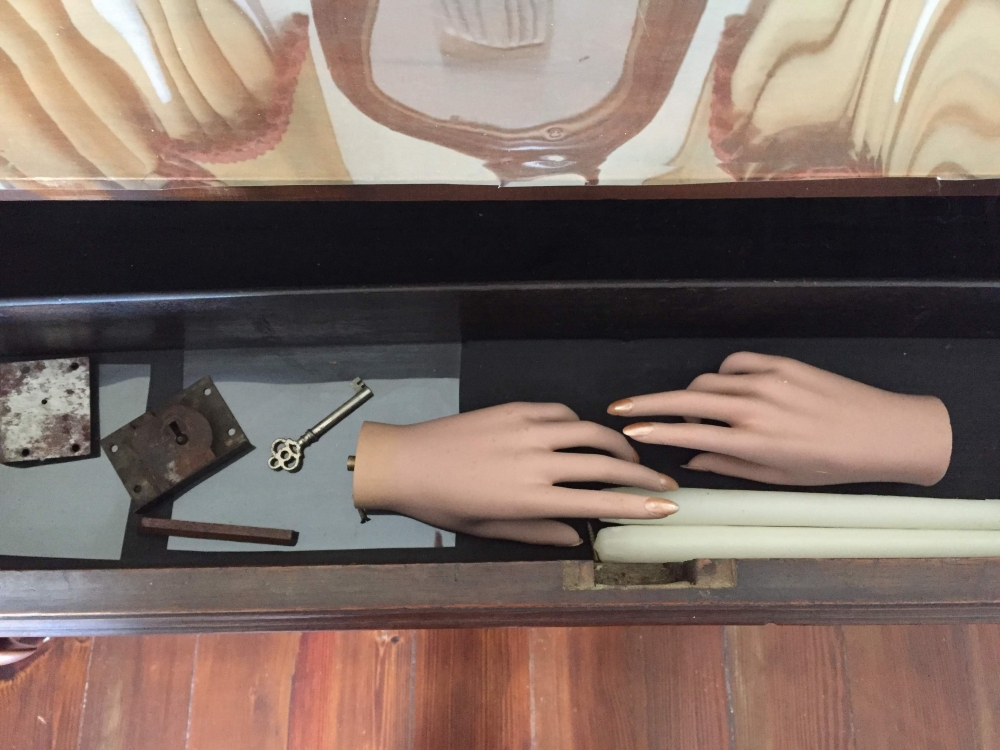 The surprising mannequin hands we found in a drawer at Gaineswood in Alabama.
The surprising mannequin hands we found in a drawer at Gaineswood in Alabama.
Each summer I make a mental note of fascinating items from the late 19th or early 20th centuries I like to call “too modern to catalog.” From ice crushing bags to a stash of 1940s magazines to mid-century appliances, the material culture of the Gulf South doesn’t stop at the Civil War.
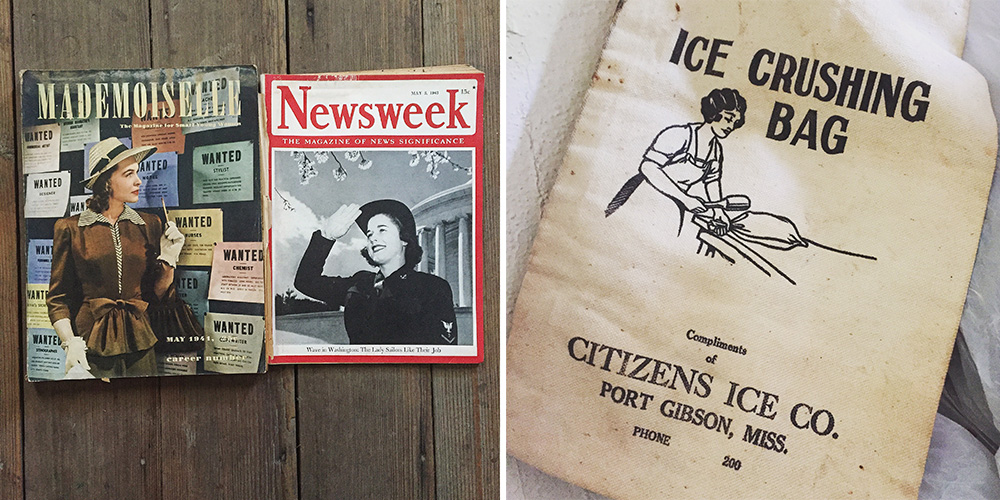 Left: Some of the vintage magazine collection the 2017 team discovered in Camden, Alabama. Right: An ice crushing bag I spotted in a Port Gibson, Mississippi, kitchen.
Left: Some of the vintage magazine collection the 2017 team discovered in Camden, Alabama. Right: An ice crushing bag I spotted in a Port Gibson, Mississippi, kitchen.
Pets on Parade
Animals are a beloved part of southern culture, especially in rural areas. Meeting pets at a fieldwork site is always a highlight for DAGS teams. Over the years I have encountered more than I can count, including a cat who loved to sit on research materials, a curious pug who photobombed our furniture shots, and a bird-hunting dog named Ziggy Stardust Jenkins. At Oakley Plantation in St. Francisville, the cries of a proud peacock named Indigo echoed around the park.
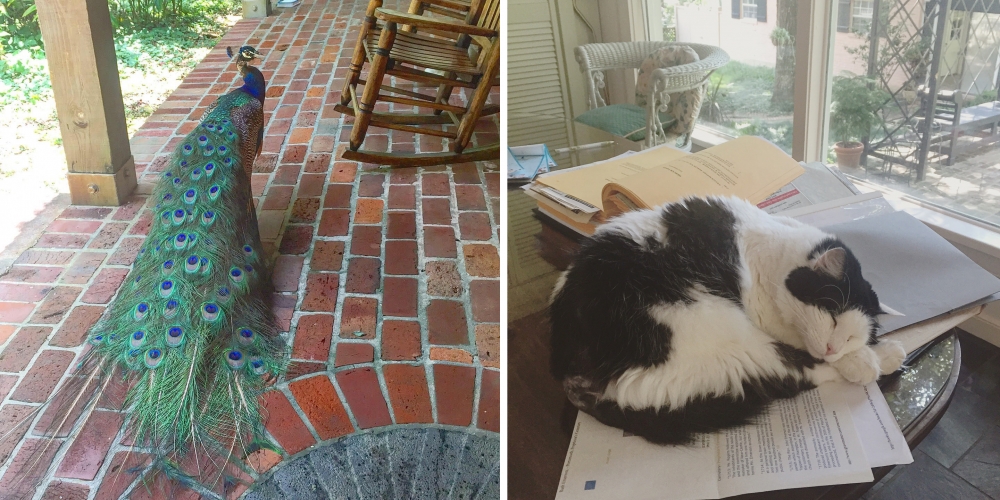 Left: Indigo the peacock struts his stuff at Oakley Plantation. Right: A sleepy cat hogs the genealogy records in Natchez, Mississippi.
Left: Indigo the peacock struts his stuff at Oakley Plantation. Right: A sleepy cat hogs the genealogy records in Natchez, Mississippi.
At a working family farm in Wilcox County, Alabama, we learned firsthand about livestock management. A curious herd of cows surrounded our vehicle, preventing us from unloading our equipment. The homeowners ushered us around back over a grate the cattle could not cross.
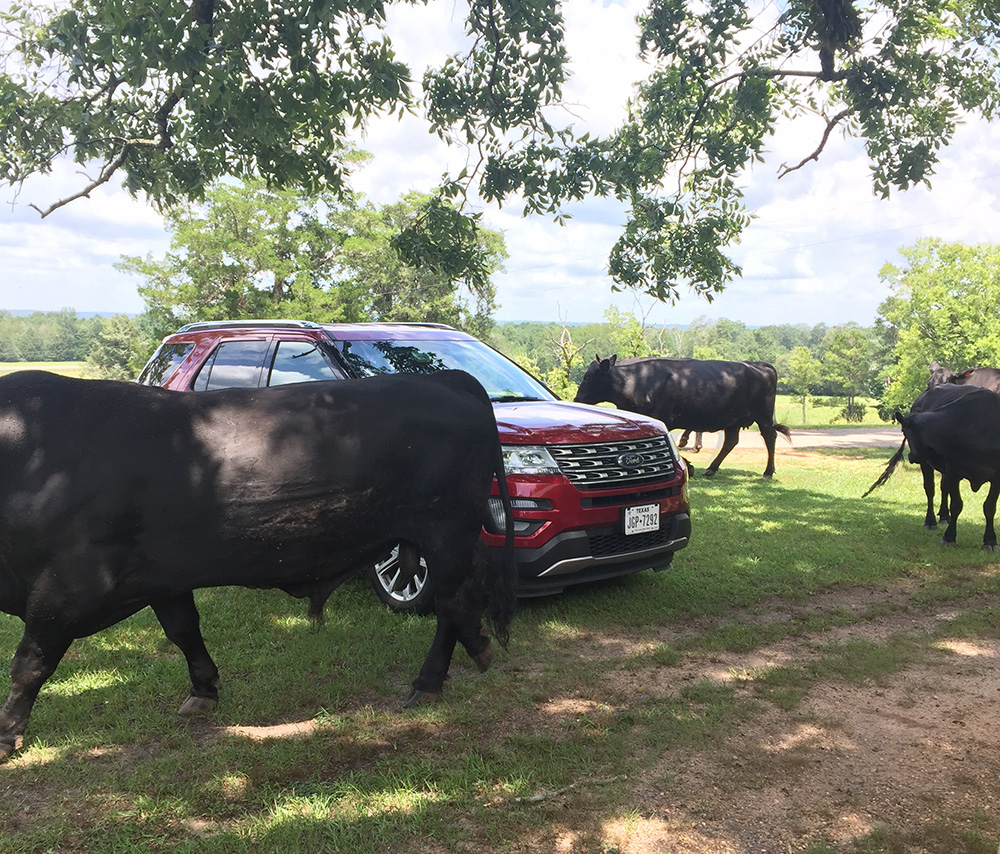 Curious cows surrounded the 2017 team’s vehicle in Camden, Alabama.
Curious cows surrounded the 2017 team’s vehicle in Camden, Alabama.
Some wildlife is harmful, like the wild hogs that rooted a trench in the front yard of our St. Francisville bed and breakfast. Lydia remembers how digging armadillos were the summer nemesis of DAGS founder Paul Haygood: “A night owl, I often got my turn on the single internet transmitter at nighttime, researching silver marks and retailers’ histories while the world around me was the pitch black of night in the country, periodically interrupted by the boom of Paul’s shotgun as he pursued the armadillo.”
Southern Hospitality
Like Blanche DuBois in the Tennessee Williams classic A Streetcar Named Desire, DAGS has always relied “on the kindness of strangers,” and Gulf South generosity has never disappointed. Not only do field work hosts let us turn their chairs upside down and examine their dresser drawers, but they also often provide free lodging. Past teams have slept in antique beds and eaten sack lunches on the very tables they just cataloged. Offers of local produce and cold drinks are plentiful; I quickly learned that refusing a 5 p.m. cocktail would be downright rude!
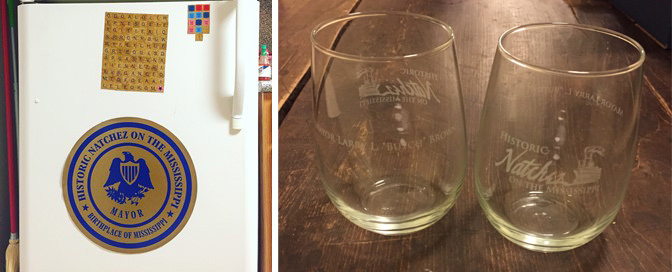
My 2016 mayoral souvenirs from Natchez.
One of my favorite fieldwork souvenirs is from former Natchez mayor Larry “Butch” Brown. He had recently retired when we visited his house in 2016, and the front hall was full of mayoral memorabilia. Eager to clear out the space, his wife sent us all home with mementos. I declined the shovel from a local ground-breaking, but the wine glasses etched with the town logo were a welcome gift. A large magnet made to label official vehicles still adorns my refrigerator, and I smile every time I see it.
Want to help the DAGS project? If you have questions about DAGS, or want suggest a potential fieldwork site, contact DAGS Coordinator and Research Curator Sarah Duggan at sarah.duggan@hnoc.org.
Explore the first 10 years of the Decorative Arts of the Gulf South project at the exhibition Pieces of History.

